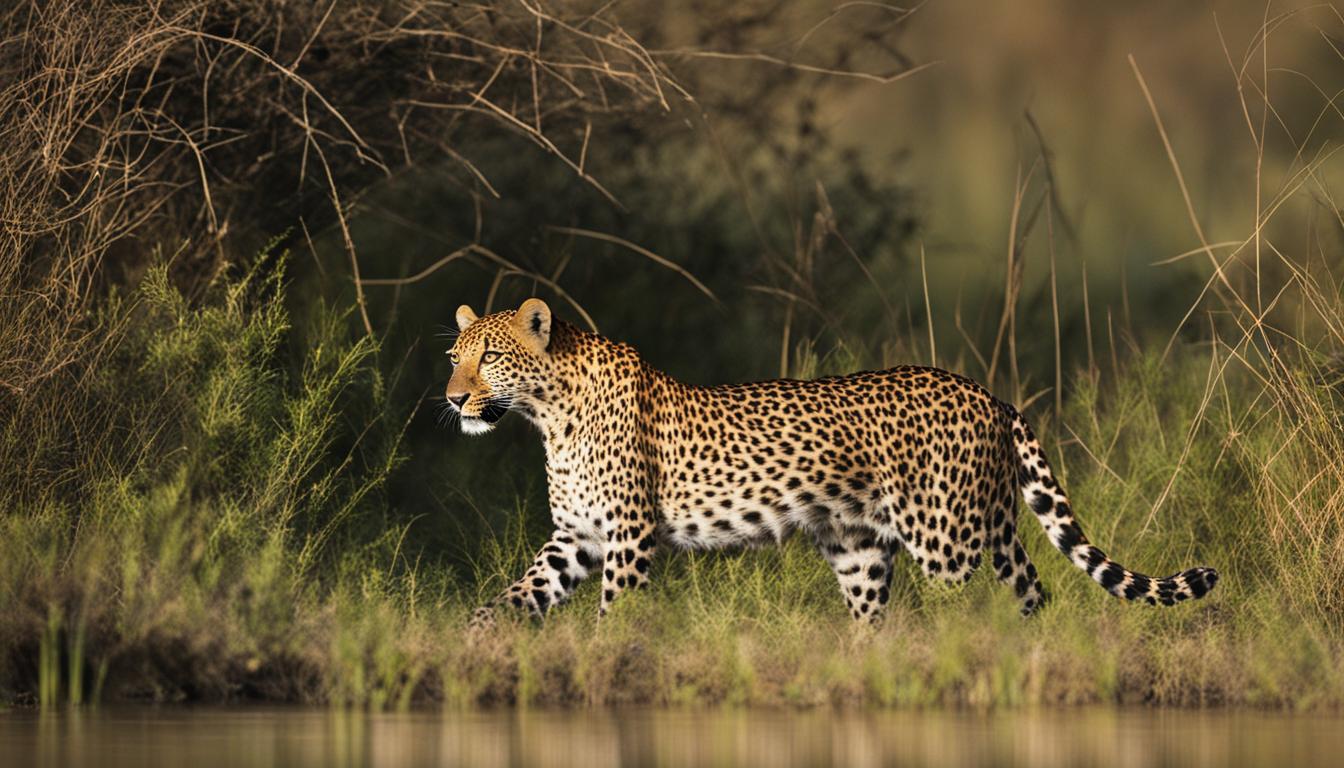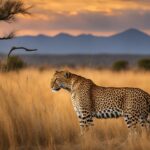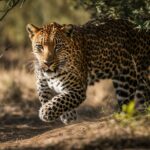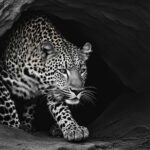Leopards, the magnificent big cats belonging to the Panthera pardus species, are known for their adaptability and incredible hunting skills. But did you know that even these powerful predators have their own set of enemies in the wild?
When it comes to leopard natural predators, three top contenders come to mind: the mighty lion, the cunning hyena, and the unexpected crocodile. These formidable creatures often pose a threat to leopards, especially vulnerable individuals like cubs or injured adults.
Lions, weighing up to a staggering 550 pounds, are the kings of Africa’s savannah and can overpower leopards if they perceive them as competitors or a potential threat to their cubs. Hyenas, known for their pack-hunting behavior, are highly efficient hunters and have been known to target leopard cubs for a hearty meal. As for crocodiles, their ambush tactics near water bodies make them an unconventional but dangerous predator for leopards.
These natural predators, combined with human activities such as habitat loss and hunting, pose significant challenges to leopard populations. Nevertheless, conservation efforts are underway to protect these endangered species and ensure their survival for generations to come.
Lion – A Natural Predator of Leopards
Leopards, powerful and agile predators, face threats from various natural enemies in the wild. One of their most significant adversaries is the lion, the largest cat species in Africa. With their massive size and strength, lions have been known to overpower leopards, especially in certain circumstances.
“Although direct conflicts between lions and leopards are relatively rare, lionesses may ambush and kill solitary adult male leopards,” explains wildlife expert Dr. Jane Thompson. Lions, being social animals, prioritize the safety of their pride and cubs. They perceive leopards as potential competitors and threats to their own survival. As a result, lionesses may attack and eliminate solitary adult male leopards to maintain territorial dominance.
“Lions recognize the importance of eliminating potential rivals and reducing competition for resources,”
This aggressive behavior extends to leopard cubs as well. Lionesses, being highly protective of their own offspring, may attack and kill leopard cubs to eliminate potential future rivals. These attacks can have a profound impact on leopard populations, disrupting their reproduction cycle and reducing their chances of reaching adulthood. The interplay between lions and leopards represents a fascinating dynamic in the wild, where survival is a constant battle for dominance and resources.
| Lion – A Natural Predator of Leopards | Key Points |
|---|---|
| Lions may ambush and kill solitary adult male leopards. | Example: Lionesses eliminate potential rivals to maintain territorial dominance. |
| Lions perceive leopards as competitors and a threat to their cubs. | Example: Lionesses attack leopard cubs to reduce future competition. |
| Attacks on leopard cubs disrupt their reproduction cycle and reduce their chances of survival. | Example: Leopard populations suffer from a lack of successful reproduction due to lion attacks. |
The constant struggle between leopards and lions reflects the challenges faced by these magnificent creatures in their natural habitats. While they possess remarkable adaptability and survival instincts, it is crucial to protect and conserve both leopard and lion populations to maintain the delicate balance of ecosystems and preserve the rich biodiversity of our planet.
Hyena – A Potential Threat to Leopards
Hyenas, both spotted and striped, pose a significant threat to leopards in the wild. These scavengers turned hunters are highly efficient pack animals known for their boldness and opportunistic feeding habits. While leopards are solitary creatures, they are not immune to the dangers posed by hyenas. In fact, hyenas have been known to hunt and kill leopard cubs when the opportunity arises.
Hyenas’ superior pack-hunting skills and their ability to overpower larger prey make them formidable predators in their own right. Leopards, especially vulnerable cubs, can fall victim to these relentless hunters. The hyenas’ coordinated attacks and their tendency to steal fresh kills from leopards further emphasize the threat they pose to the survival of leopards in certain habitats.
To better understand the danger hyenas pose to leopards, it is important to consider their pack dynamics. Hyena packs, led by dominant females, exhibit a strict social hierarchy where cooperation and teamwork are paramount. This enables them to bring down larger prey and defend their territory effectively. Unfortunately, the power and cunning of hyenas can be detrimental to the survival of leopard cubs, disrupting their reproduction cycle and diminishing their chances of reaching adulthood.
| Hyena vs Leopard | Advantage | Disadvantage |
|---|---|---|
| Strength | Hyenas are powerful predators with a strong bite force, capable of overpowering leopards. | Leopards are agile climbers and can escape into trees to avoid hyenas. |
| Social Behavior | Hyenas hunt in packs, offering strength in numbers and coordination during attacks. | Leopards are solitary creatures and may struggle to defend themselves against multiple hyenas simultaneously. |
| Stealth | Hyenas can track and ambush leopards, taking them by surprise. | Leopards possess exceptional camouflage skills and can blend into their surroundings, evading detection by hyenas. |
As the table above highlights, while leopards have certain advantages over hyenas, the unpredictable nature of these encounters can result in devastating consequences for the leopards. Therefore, it is crucial to protect leopard habitats and promote conservation efforts to ensure the survival of these majestic big cats in the face of threats from predators like hyenas.
Crocodile – An Unconventional Predator of Leopards
Leopards, as agile and stealthy predators, face a range of threats in the wild. While lions and hyenas are commonly known as their natural enemies, there is another unconventional predator that poses a danger to leopards – the crocodile. Although not a traditional adversary, crocodiles lurking near waterholes and rivers can ambush and snatch leopards, especially when they venture too close to the water’s edge.
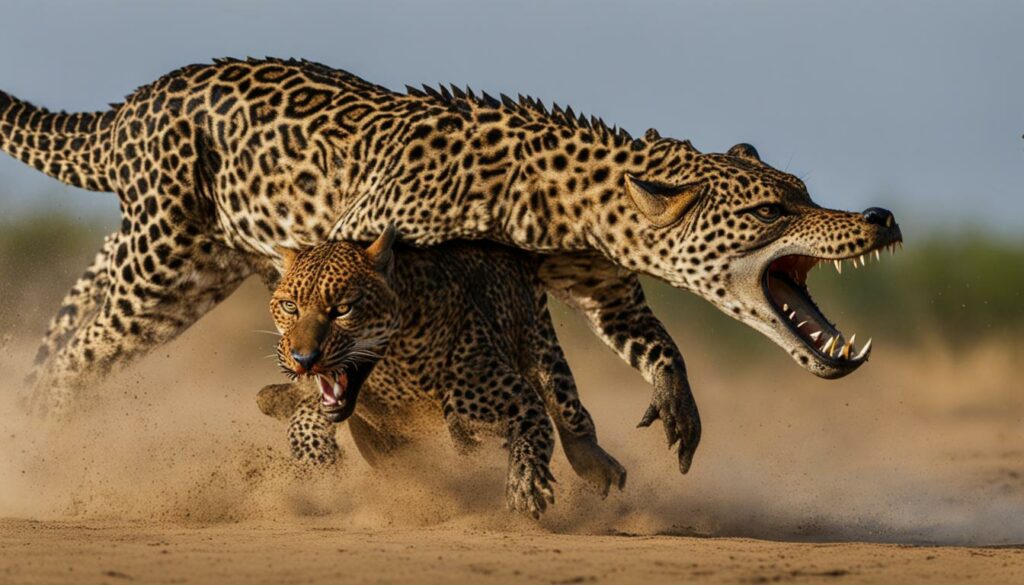
Unlike lions and hyenas, crocodiles have an aquatic lifestyle, spending most of their time in the water. Leopards may not expect to encounter such a formidable predator in their habitat, making them particularly vulnerable during their interactions near water sources. Juvenile crocodiles and hatchlings, in particular, are at greater risk of falling prey to leopards, as they are less capable of defending themselves.
While the occurrence of crocodile attacks on leopards may not be as frequent as encounters with lions or hyenas, the presence of these reptiles certainly adds another layer of danger to the survival of leopards in certain habitats. The ability of crocodiles to quickly ambush and overpower their prey presents a significant threat, potentially impacting local leopard populations.
| Crocodile Attacks on Leopards | Impact on Leopard Populations |
|---|---|
| Unconventional predator | Disrupts natural balance |
| Target vulnerable individuals | Reduces chances of reaching adulthood |
| Preys on hatchlings and juveniles | Threatens reproduction cycle |
| Ambushes near water sources | Poses danger to leopards near water |
As efforts to protect leopard populations continue, understanding the full range of threats they face is crucial. While crocodile attacks may not be as well-documented as those by lions or hyenas, their presence in leopard habitats should not be overlooked. Conservation initiatives should take into account the complex dynamics between leopards and their unconventional predators, ensuring the development of comprehensive strategies for the ongoing survival and protection of this magnificent big cat species.
Conclusion
Leopards, as magnificent apex predators, face a range of natural threats in the wild. Lions, hyenas, and even crocodiles can pose a danger to the survival of these fascinating big cats. However, it’s not just natural predators that put leopards at risk.
Human activity, including habitat loss and hunting, poses a significant threat to leopard populations. As their habitats are encroached upon and their prey is depleted, leopards struggle to thrive. To combat these challenges and protect these endangered species, conservation efforts are crucial.
Various organizations are actively working to monitor and survey leopard populations. By studying their behavior and habitats, experts can implement effective conservation strategies. These efforts aim to ensure the continued existence of leopards for future generations to admire and appreciate.
Leopards’ adaptability and diverse diet enable them to survive in a wide range of habitats, spanning from Africa to the Middle East and Asia. However, the importance of preserving these apex predators and their habitats cannot be overstated. By supporting conservation initiatives and raising awareness about the threats they face, you can contribute to the long-term survival of these incredible creatures.
Do leopards climb trees to escape from their natural predators in the wild?
Yes, leopards climbing trees explained: Leopards are known for their exceptional climbing abilities and use trees to escape from their natural predators such as lions and hyenas. They seek refuge in trees to keep themselves safe and out of reach from other predators on the ground.
FAQ
Are there any natural predators of leopards in the wild?
Yes, leopards have natural predators in the wild. Some of their natural enemies include lions, hyenas, and crocodiles.
How do lions pose a threat to leopards?
Lions, being the largest cats in Africa, can kill leopards. While direct conflicts between lions and leopards are rare, lionesses may ambush and kill solitary adult male leopards. Lions may also attack and kill leopard cubs, perceiving them as competitors and a threat to their own cubs.
Why are hyenas a potential threat to leopards?
Both spotted and striped hyenas have been observed hunting and killing leopard cubs when the opportunity arises. Hyenas are highly efficient pack hunters and can overpower leopards, posing a danger to both solitary individuals and vulnerable cubs.
Can crocodiles pose a threat to leopards?
While not a traditional predator of leopards, crocodiles can be a threat, especially near water holes and rivers. Crocodiles can ambush and snatch leopards if they venture too close to the water’s edge. Juvenile crocodiles and hatchlings are particularly vulnerable to predation by leopards.
What are the key threats to leopard populations?
Leopards face threats from habitat loss and hunting by humans. These factors have a significant impact on leopard populations and their survival. Conservation efforts, including monitoring and surveying leopard populations, are essential for their protection and preservation.

